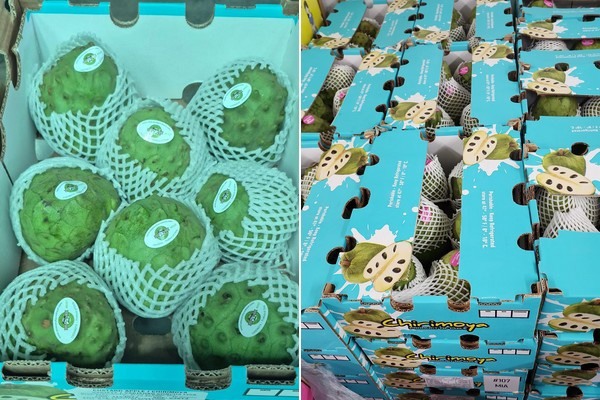Cherimoyas are in peak supply right now. "The peak of the season is August through October, when a lot of fruit is coming in exclusively by air freight from Chile. So we have good supply with good sizing," says Nick Bernal of Seasons Farm Fresh.
In Chile, there are two main growing regions for cherimoyas with the early growing region starting in May and finishing around the end of July. The second growing region starts when the first growing region ends and the bulk of the crop comes from this latter region, which is further north. "Chile got a bit of a late start by a few weeks because it was a colder and wetter winter than years past. It's a spring fruit–it needs to be above a certain temperature for the fruit to start to mature and ripen on the tree," Bernal says.
 © Seasons Farm Fresh
© Seasons Farm Fresh
Exports vs. domestic consumption
Generally, from Chile, only 20-25 percent of the crop is exported because the rest is domestically consumed, though Bernal believes this year more fruit is being shipped to the U.S., even though the crop is down slightly. Meanwhile, Spain is the largest producer of cherimoya in the world, growing three times the amount of fruit that Chile does. In turn, Spain supplies largely the European market.
Back in the U.S. market, Seasons Farm Fresh, who has been shipping the fruit for 10 years now supplying wholesale, retail and foodservice programs on the East Coast, has seen interest in the fruit grow steadily in that time. "Every year, more retailers carry it, especially since the pandemic," says Bernal. "Americans are starting to venture out of just apples, bananas and oranges and into that spectrum of fruits such as cherimoya, soursop fruits and others. It widens the market from New York, LA, Miami to the heartland of America–people in Iowa and Nebraska are trying these fruits now."
As for pricing, the fruit is a premium priced one given the demands in growing it–it's hand-pollinated, needs to be picked at the right time and is also shipped by air. "However prices have come off a bit, even with tariffs and air freight costs going up every year. They're coming off because we're in peak volume and growers are motivated to push more volume," says Bernal, noting that promotions are also taking place to move the fruit.
 © Seasons Farm Fresh
© Seasons Farm Fresh
Remainder of season
Given the fact that it's the midway point of the Chilean cherimoya season, pricing is anticipated to level off, though there will still be some volume sent to market. "We're hoping to find more outlets for the fruit so the market doesn't become saturated," says Bernal. "This isn't a banana or apple–you can't just send millions and millions of boxes and expect the market to take at all. There is kind of a limit but every year we're pushing the limit up."
He hopes that the season will go until the end of October to early November–typically it runs until about the third week of November. "Last year we were cut short because of the cherry season. Chile started early and air freight doubled overnight, so that put the price point of the fruit out of most people's hands," he says. "I don't know if we'll see this again this year."
 For more information:
For more information:
Nick Bernal
Seasons Farm Fresh, Inc.
Tel: +1 (305) 608-9020
https://seasonsfarmfresh.com/
